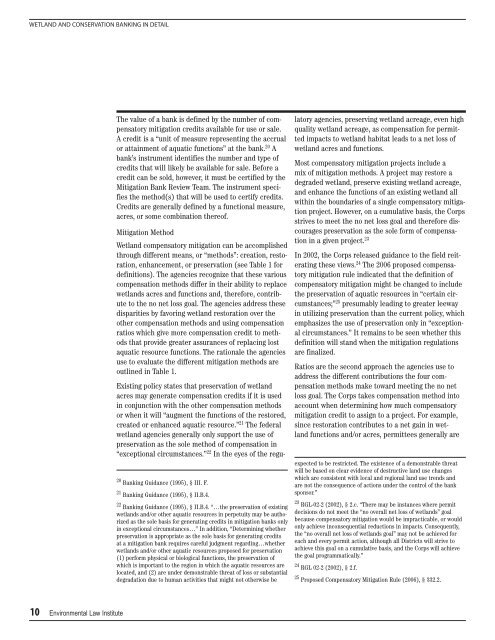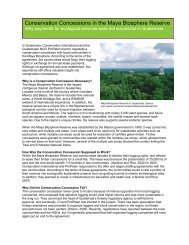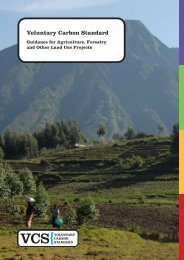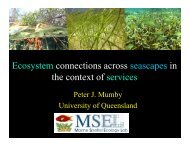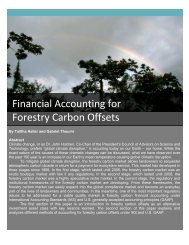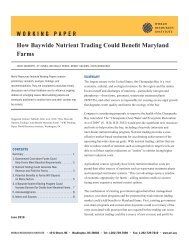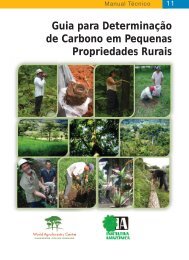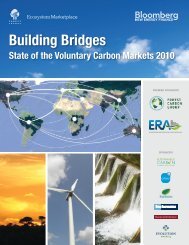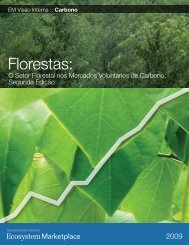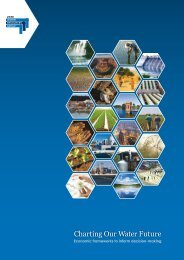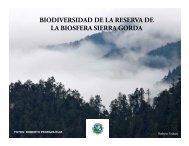Design of US Habitat Banking Systems to Support the Conservation ...
Design of US Habitat Banking Systems to Support the Conservation ...
Design of US Habitat Banking Systems to Support the Conservation ...
Create successful ePaper yourself
Turn your PDF publications into a flip-book with our unique Google optimized e-Paper software.
WETLAND AND CONSERVATION BANKING IN DETAILThe value <strong>of</strong> a bank is defined by <strong>the</strong> number <strong>of</strong> compensa<strong>to</strong>rymitigation credits available for use or sale.A credit is a “unit <strong>of</strong> measure representing <strong>the</strong> accrualor attainment <strong>of</strong> aquatic functions” at <strong>the</strong> bank. 20 Abank’s instrument identifies <strong>the</strong> number and type <strong>of</strong>credits that will likely be available for sale. Before acredit can be sold, however, it must be certified by <strong>the</strong>Mitigation Bank Review Team. The instrument specifies<strong>the</strong> method(s) that will be used <strong>to</strong> certify credits.Credits are generally defined by a functional measure,acres, or some combination <strong>the</strong>re<strong>of</strong>.20 <strong>Banking</strong> Guidance (1995), § III. F.21 <strong>Banking</strong> Guidance (1995), § II.B.4.22 <strong>Banking</strong> Guidance (1995), § II.B.4. “…<strong>the</strong> preservation <strong>of</strong> existingwetlands and/or o<strong>the</strong>r aquatic resources in perpetuity may be authorizedas <strong>the</strong> sole basis for generating credits in mitigation banks onlyin exceptional circumstances…” In addition, “Determining whe<strong>the</strong>rpreservation is appropriate as <strong>the</strong> sole basis for generating creditsat a mitigation bank requires careful judgment regarding…whe<strong>the</strong>rwetlands and/or o<strong>the</strong>r aquatic resources proposed for preservation(1) perform physical or biological functions, <strong>the</strong> preservation <strong>of</strong>which is important <strong>to</strong> <strong>the</strong> region in which <strong>the</strong> aquatic resources arelocated, and (2) are under demonstrable threat <strong>of</strong> loss or substantialdegradation due <strong>to</strong> human activities that might not o<strong>the</strong>rwise beMitigation MethodWetland compensa<strong>to</strong>ry mitigation can be accomplishedthrough different means, or “methods”: creation, res<strong>to</strong>ration,enhancement, or preservation (see Table 1 fordefinitions). The agencies recognize that <strong>the</strong>se variouscompensation methods differ in <strong>the</strong>ir ability <strong>to</strong> replacewetlands acres and functions and, <strong>the</strong>refore, contribute<strong>to</strong> <strong>the</strong> no net loss goal. The agencies address <strong>the</strong>sedisparities by favoring wetland res<strong>to</strong>ration over <strong>the</strong>o<strong>the</strong>r compensation methods and using compensationratios which give more compensation credit <strong>to</strong> methodsthat provide greater assurances <strong>of</strong> replacing lostaquatic resource functions. The rationale <strong>the</strong> agenciesuse <strong>to</strong> evaluate <strong>the</strong> different mitigation methods areoutlined in Table 1.Existing policy states that preservation <strong>of</strong> wetlandacres may generate compensation credits if it is usedin conjunction with <strong>the</strong> o<strong>the</strong>r compensation methodsor when it will “augment <strong>the</strong> functions <strong>of</strong> <strong>the</strong> res<strong>to</strong>red,created or enhanced aquatic resource.” 21 The federalwetland agencies generally only support <strong>the</strong> use <strong>of</strong>preservation as <strong>the</strong> sole method <strong>of</strong> compensation in“exceptional circumstances.” 22 In <strong>the</strong> eyes <strong>of</strong> <strong>the</strong> regula<strong>to</strong>ryagencies, preserving wetland acreage, even highquality wetland acreage, as compensation for permittedimpacts <strong>to</strong> wetland habitat leads <strong>to</strong> a net loss <strong>of</strong>wetland acres and functions.Most compensa<strong>to</strong>ry mitigation projects include amix <strong>of</strong> mitigation methods. A project may res<strong>to</strong>re adegraded wetland, preserve existing wetland acreage,and enhance <strong>the</strong> functions <strong>of</strong> an existing wetland allwithin <strong>the</strong> boundaries <strong>of</strong> a single compensa<strong>to</strong>ry mitigationproject. However, on a cumulative basis, <strong>the</strong> Corpsstrives <strong>to</strong> meet <strong>the</strong> no net loss goal and <strong>the</strong>refore discouragespreservation as <strong>the</strong> sole form <strong>of</strong> compensationin a given project. 23In 2002, <strong>the</strong> Corps released guidance <strong>to</strong> <strong>the</strong> field reiterating<strong>the</strong>se views. 24 The 2006 proposed compensa<strong>to</strong>rymitigation rule indicated that <strong>the</strong> definition <strong>of</strong>compensa<strong>to</strong>ry mitigation might be changed <strong>to</strong> include<strong>the</strong> preservation <strong>of</strong> aquatic resources in “certain circumstances;”25 presumably leading <strong>to</strong> greater leewayin utilizing preservation than <strong>the</strong> current policy, whichemphasizes <strong>the</strong> use <strong>of</strong> preservation only in “exceptionalcircumstances.” It remains <strong>to</strong> be seen whe<strong>the</strong>r thisdefinition will stand when <strong>the</strong> mitigation regulationsare finalized.Ratios are <strong>the</strong> second approach <strong>the</strong> agencies use <strong>to</strong>address <strong>the</strong> different contributions <strong>the</strong> four compensationmethods make <strong>to</strong>ward meeting <strong>the</strong> no netloss goal. The Corps takes compensation method in<strong>to</strong>account when determining how much compensa<strong>to</strong>rymitigation credit <strong>to</strong> assign <strong>to</strong> a project. For example,since res<strong>to</strong>ration contributes <strong>to</strong> a net gain in wetlandfunctions and/or acres, permittees generally areexpected <strong>to</strong> be restricted. The existence <strong>of</strong> a demonstrable threatwill be based on clear evidence <strong>of</strong> destructive land use changeswhich are consistent with local and regional land use trends andare not <strong>the</strong> consequence <strong>of</strong> actions under <strong>the</strong> control <strong>of</strong> <strong>the</strong> banksponsor.”23 RGL-02-2 (2002), § 2.c. “There may be instances where permitdecisions do not meet <strong>the</strong> “no overall net loss <strong>of</strong> wetlands” goalbecause compensa<strong>to</strong>ry mitigation would be impracticable, or wouldonly achieve inconsequential reductions in impacts. Consequently,<strong>the</strong> “no overall net loss <strong>of</strong> wetlands goal” may not be achieved foreach and every permit action, although all Districts will strive <strong>to</strong>achieve this goal on a cumulative basis, and <strong>the</strong> Corps will achieve<strong>the</strong> goal programmatically.”24 RGL 02-2 (2002), § 2.f.25 Proposed Compensa<strong>to</strong>ry Mitigation Rule (2006), § 332.2.10 Environmental Law Institute


